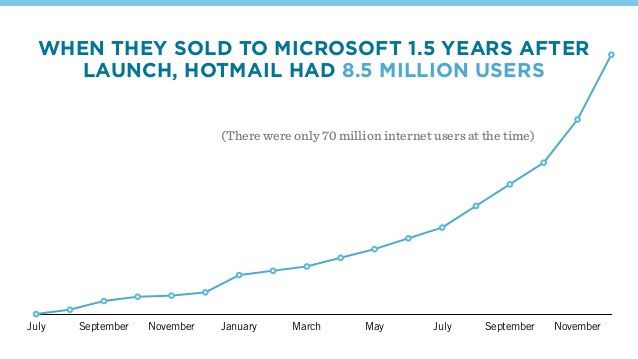Growth hacking goes beyond digital marketing

Companies say that the concept of “growth hacking” is a novel one — especially in the era of online marketing.
Though the techniques and channels that you can use to hack a business’s growth have indeed multiplied, the discipline has not. It’s still about using a variety of means to achieve an increase in the metrics.
And if there’s one thing growth-driven companies have learned, it’s that growth hacking will give back to you exactly the effort you put in. No more, no less.
Just ask Buzzfeed, the viral website that began as a side-hustle by one of the co-founders of the Huffington Post. It went from curating Internet memes to actually setting the agendas and standards of viral marketing.
In just six years, the company managed to grow to 30 million visitors per month. But the best part is that they came from friends, colleges, celebrity mentions, and referrals — not Google searches.
That astronomical growth continued to skyrocket until BuzzFeed’s global audience grew to 200+ million unique visitors and over 6 billion global content views
And they owe it all to unique strategies that surround the broader universe of growth hacking.
To growth hack, start with a growth mindset
Bold but bootstrapping willingness to hustle clients until land enough to hire a team should tell you something important about growth hacking:
- Use any means necessary to accomplish your goal.
- Rely on traditional techniques that are proven to work when you’re first starting out even if they take you “offline.”
- Move fast and think outside the box because growth — of revenue and operations — is your only “true north.”
Though Sean Ellis first coined the term growth hacker in 2010, the convergence of growth hacking has been around since the days of — no, not Facebook — Hotmail.
After a flopped launch, and thousands of dollars spent on billboard and radio ads as their growth strategy, it took only a simple call-to-action at the bottom of an email to skyrocket their growth to a million users in 6 months.
And five weeks after that, they doubled their growth to 2 million users.

The fact is that, when it comes to hacking growth, ideas are only as good as execution. And you never know which idea is going to get you from an unimpressive launch, to 3,000 users a day, to 8.5 million users in 1.5 years.
What is growth hacking anyway?
Though it gets bandied about a lot as a buzzword, growth hacking, as a term and as an activity in business, is still poorly understood.
It often gets lumped under digital marketing, and when you name-drop the G-word, people start talking excitedly about conversion rates, customer acquisition, and scalable strategies.
Things start to get real vague, real fast.
To get specific, I turn to Andrew Chen, general partner at Andreessen Horowitz, who deftly captures growth hacking:
“Growth hackers are a hybrid of marketer and coder, one who looks at the traditional question of, ‘How do I get customers for my product?’ and answers with A/B tests, landing pages, viral factor, email deliverability, and Open Graph. On top of this, they layer the discipline of direct marketing, with its emphasis on quantitative measurement, scenario modeling via spreadsheets, and a lot of database queries.”
As a specialist in investments for consumer startups and former Rider Growth at Uber, Chen knows of which he speaks. Several key words in his description also stand out to me, as they should to you: “hybrid,” “quantitative measurement,” “traditional,” and “discipline.”
So, are growth hackers engineers? They can be.
Are they marketers? Certainly, they have the DNA of a marketer.
Are they product managers? Anybody who has built a SaaS from the ground up will recognize elements of the need for cross-functional teams under a “Head of Growth.”
The iceberg concept should give you an accurate visual for the sheer depth and breadth of activities that growth hacking could entail. The fact is that growth is what you see — but how you make it come about requires the harmonious dance of several different niches of expertise.

That’s why growth hackers are a hybrid and their means are as varied as their role. They’re non-traditional with their approach to problem solving — and the “problem” they’re solving for is growth. Based on the stage of the startup, that could mean customers, users, revenue, retention, and more.
They’re platform-, strategy-, and method-agnostic. If it works, they’ll work it. And with such a broad scope, it’s no wonder, then, that we all slip into vague notions of what a Growth Hacker actually does or brings to the table.
According to the Harvard Business Review,
“[T]he Growth Manager’s job has three core components:
- First, to define the company’s growth plan,
- Second, to coordinate and execute growth programs,
- And, third, to optimize the revenue funnel.
In my experience with startups, the one thing — maybe even the only thing — growth hackers have in common is a growth mindset. Everything else derives from this growth mindset.
Vince Weberink, CEO at TVMucho and Wowzers, has this to say about growth hacking:
“Fundamentally, it is a mindset. As long as you approach it with the right mindset and you follow a process that works, there is no difference whether you do a SaaS or products or a service or even a restaurant. You can growth-hack your own life! It’s really about following those steps and continuing to churn out those experiments.”
Armed with a growth mindset, your startup can take on a variety of strategies to grow. And while it does include digital marketing, the real cases of many startups prove that you’ve got to go beyond a GUI to grow.
Does your startup business need a growth hacker?
Experimentation — and the data that flows in from those experiments — is at the heart of every effective growth hacking process.
If you have a dedicated Growth Manager, for example, the first thing they’ll do is set up the data and automation infrastructure your business needs to track meaningful metrics like:
- User behavior
- Scientific experimentation
- Targeted promotions
These “experiments” will help them gain a zoomed-out view on details like dropoff rates. Are they a result of churn or poor user acquisition? Through timed sprints of 4, 8, and 12 weeks, growth hacking experiments can help give startups the clarity they need at a time when it’s all hands on deck.
Startups are lean, mean, action-oriented machines. Tight budgets and even smaller stores of manpower mean that they’re naturally driven to make every penny count.
It’s a naturally fast-paced and pressurized environment, so growth hackers are the leaders that tell others in a startup when to pivot, when to try something new, and when bad outcomes from experiments means something needs to be killed off, stat.
Depending on the scope of your growth goals, your growth hacker may:
- Have hands-on experience with CRM and automation
- Know the front and back-end of paid customer acquisition (paid ads)
- Choose and use tools with data analytic features to track user activity, conversions, interactions, and more
- Be able to plan and work closely with technical team for integrations between tools and software
- Be a funnel master, with deep knowledge on how to optimize customer journeys
- Harness psychological and persuasion principles to market products, onboard, and retain users
To see this in action, let me make the punchline of many, many jokes our focus here for a moment: Tinder.
Tinder and its explosive growth has a lot more to do with strategic, data-driven experiments and way less to do with bored singles swiping left and right. The very fact that “swiping left” has come to mean “a hard pass” in our cultural zeitgeist today is a testament to Tinder’s early traction methods:
- Create an “addictive app” through novel and gamified user experience based on new social norms of casual dating
- Build a robust marketplace of supply and demand
- Take advantage of networks through college-by-college launches
Tinder’s gamification game going strong
Once it hit a certain tipping point of users, Tinger’s growth team could then turn their attention to retaining current users and attracting new users. This time, however, they did it through product enhancement:
- Press that continues to drive growth
- Product extensions that broaden the scope of users (outside of just singles looking to connect)
- Product features designed to re-engage and retain
- International expansion
- Monetizing access to certain features
With data and user feedback, this feature would not have landed.
So here’s the takeaway for you, young padawan startup: Growth hacking involves digital marketing but it doesn’t stop there. It doesn’t stop anywhere. Growth hacking addresses all aspects of revenue growth, product sophistication, and community building — to name a few.
5 growth hacking strategies for startups that work
Observing growth hacking in action is not a rare sight. But because it calls on so many different disciplines, you may be looking right at it while failing to truly perceive it.
You’re forgiven for confusing growth hacking with purely digital marketing techniques — because any business that operates online — which, these days, is almost every business around — your techniques will necessarily call on online advertising.
However, there’s more than one way to slice the profitability apple and these five strategies show you how to carve out your chunk of growth.
1. Offer a double referral incentive
Follow Dropbox’s lead — and, indeed, many a SaaS product today — on this technique.
To increase its sign-ups and decrease their cost per user acquired, Dropbox offered a “double” referral to its current users. Here’s how it worked:
- Users would send a referral link to a friend in exchange for extra storage space
- If the friend signed up for an account using this specific link, they would also receive extra storage space
This neat-and-simple technique reportedly increased Dropbox’s sign-up rates by 60%. It also accurately confirmed to Dropbox what users are truly motivated by.
2. Connect with customers at conferences
As they say, go where your customers are. In the case of startups, you’ve got to be crystal clear on who your ideal customers are, where they live, what their pain points are, and what they’re looking to solve with your solution.
Now, I’m giving you permission to skip those startup-centric conferences and head to an event where this ideal customer would be. For the creators of Airstory, a copywriting tool, for example, that might be any copywriter conference (or virtual event).
You’ll be able to learn more about their issues through conversations, and you can subtly introduce your tool as a potential solution.
Hey, it’s time consuming, but having face-to-face conversations can definitely help bring new users aboard.
3. Integrate a corollary product, service, or API
This is a fantastic way to gain some early traction — simply piggyback off the users from another popular app. Unsurprisingly, a Facebook integration is one of the most popular.
However, I encourage you to think about what your users are truly going to benefit from.
Calendly, for example, offers integrations with Google Calendar and your email marketing software. Now, not everyone is a user of, say, an email marketing service like Mailchimp.
But almost everyone uses Google Calendar in some form, especially for meetings. Suddenly, users of Google Calendar find it convenient to pay for a Calendly subscription so that both they, and their clients who want to schedule appointments, can experience a seamless and automated workflow.
4. Pre-launch and then pre-target
The pre-launch and pre-target method is incredibly powerful. However, it is a mini-project in itself, so be sure to plan it out properly.
- Offer access to a product, service, or feature that hasn’t rolled out yet
- Using a drip email campaign and a specific method for introducing this offer to others, build a “pre-launch” email list consisting of individuals who are interested in gaining access when this offer goes live.
- Next, upload this list of emails, which have already been qualified as “warm leads” to an ad platform like Facebook. You’ll be able to create lookalike audiences and create custom audiences to grow that list even faster.
5. Create an air of exclusivity
There are quite a few apps that have harnessed the “air of exclusivity” growth hack, but the one that immediately caught my attention was Dribbble. Exclusivity is baked right into their “mission” since their birth in 2009.
Instead of creating a glut in the design market, Dribbble positioned itself as a community for designers, by designers. Only designers who were invited could create an account and share their work in this “inspired” community.
It goes without saying that, even as recently as last year, there are still posts asking, “How new designers can get invited to Dribbble?” Notice how Dribbble still, unlike many other platforms that eventually open up their borders (such as Facebook circa 2007), maintains its air of exclusivity.
It’s not just about a slower rollout, phasing users, testing features, or being cautious with their marketing budget. Even if that’s the reality in the backend of the company, users are never the wiser.
This air of exclusivity is now synonymous with the Dribbble experience and platform. And, in a funny twist, it actually heightens the perception that designers on Dribble are “serious” and “high-quality.”
Rather than create a lack of users, this experience of “wanting what you can’t have” creates a perpetual demand for access to Dribbble.
It’s basically every SaaS platform’s dream.
Conclusion
One thing every startup should prepare for when putting on their Growth Mindset goggles is that product changes may be inevitable. These can be simple change requests or total overhauls of a UI. That just means growth initiatives are working, and the internal team is light, agile, and responsive enough to be able to implement quickly and efficiently.
However, it might be useful to create a framework for testing that clearly spells out when an idea will be embraced (success threshold), the impact, and the cost to implement. Of course, these can and should be tailored to your business, your growth stage, and your ultimate goals.
And your ultimate goal is growth, right?
No spam, no sharing to third party. Only you and me.
